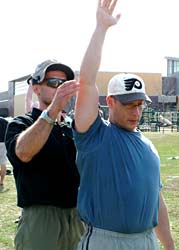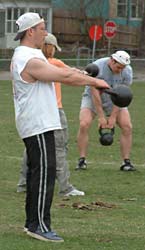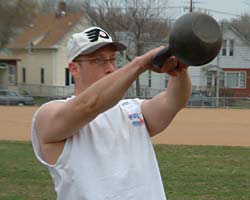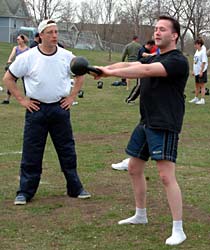How Chiropractor and ART Practitioner Glenn Hyman Helps Athletes Rehab with Kettlebells
A kettlebell success story interview with Glenn Hyman
January 18, 2011 09:36 AM


A resident of Denver, CO, Glenn Hyman is a chiropractor and Active Release Technique® Practitioner. He is also the president and owner of the Denver Chiropractic Center. Glenn received his Russian Kettlebell Challenge certification in April of 2004.
Dragon Door: What is your workout regime?
Glenn Hyman: I've been working out for probably 20 years now, and I have kettlebells in my office and at my house, so I work out just about every day.
D.D.: How did you find out about kettlebells? And what kinds of exercises were you doing before you switched to kettlebells?
G.H.: I started attending Pavel's workshops in Colorado. A friend of mine had heard about this guy who taught commando techniques, so we went to check it out. We went to all four of his classes, and it was really good stuff.
I put DragonDoor.com on my favorites, would check in frequently, and I noticed the kettlebell stuff coming out. At the time, there was only one book and a couple of kettlebells and that's it. I bought a 36-pounder and a book and got started that way.
D.D.: Do you use kettlebells with your clients?
G.H.: I actually have begun using kettlebells with patients. I do a little training in my office because I have all the kettlebells in there. I've been training some athletes, and I've also been using kettlebells extensively for rehabilitation-helping people get their backs recovered.
D.D.: How do you see the kettlebell helping with back problems?
G.H.: That's a good question. I have an interesting progression I put people through. A lot of people are terrified at the idea of getting down into a squat because they've been conditioned to avoid it. So first I teach them to do the motion correctly, with no weight, and then I teach them to squat down and pick up the kettlebell.
From there they gain confidence that they can actually do some resistance-type exercises. That seems to get them in the habit of using their pelvis and low back correctly, so they can gain strength in their spines. It works very, very well, and a lot of them end up getting hooked and buying kettlebells.
D.D.: Are there any other drills that are particularly good for backs?
G.H.: I would say that all of them are good for backs. I like to progress them first through that squat motion and then I go into the Swing, so they know how to brace their core. Then, depending on how far they want to go, I'll start teaching the Clean, and sometimes they'll work up to doing the Snatch. I think that all of the exercises, if done correctly, are very safe and effective for people who want to strengthen their backs.
D.D.: On the ART side of your business, have you seen how kettlebells can help someone after they've gone through ART treatment?
G.H.: Absolutely, because most of my business is in treating athletes for soft tissue problems, which is what the Active Release Technique is geared towards. A lot of them become involved in the kettlebell training that I do in my office, and a lot of them start using kettlebells at home. For instance, ART has an official sponsorship with Ironman, and I get a lot of Ironman competitors. They love kettlebells because it's a way they can train without bulking up or being stuck in a gym. So from those people to the contact athletes that I deal with, the ones that get involved with kettlebells just love them.
D.D.: I have a hunch that if you use kettlebells, you may reduce the incidence of soft tissue injuries. Is this true?
G.H.: Absolutely. There are couple reasons why the kettlebell is so good. One, the ballistic exercises help people with shock absorption, which is good for those who are out there pounding themselves through a long run.
The other thing I've noticed a lot is that people with shoulder problems benefit from the kettlebell. This is because in the Military Press, you're taught to keep the arm down with the lat, to keep the humerus from coming up too high. It really helps people with impingement syndrome get back into pressing, because they learn how to keep that humerus out of the way of the AC joint. Those are just two of many different ways I've found them to be helpful.
D.D.: What do you think of kettlebells in relation to traditional machines or other weight systems?
G.H.: I hate machines! I absolutely despise them. I rail against them in my practice and in the newsletter that I send out to patients. I encourage them to avoid machines like the plague, because you get locked into such unnatural ranges of motion and they don't require you to stabilize yourself in any meaningful way.
I'm more a fan of free weights in general, including the kettlebell. So I try to orient people in that direction because you can have kettlebells in your home, and you don't need a whole gym in your basement to get the work done.

D.D.: Glenn Hyman before kettlebells and Glenn Hyman now: What's the difference?
G.H.: I'd say that since starting to use kettlebells, my own shoulder problems have finally, completely been resolved. They were partially resolved from finding ART, but I was habitually irritating it. Now that Pavel's taught me to press correctly, I've been able to recuperate my shoulder.
I'm a lot stronger and I've probably put on 15 lbs. of muscle without even trying. I was shocked to weigh myself and find that I now weigh 193, where I had weighed 177 for a long time. I'm still wearing the same size pants, though, so I would say I now have lower body fat.
D.D.: How has the kettlebell certification been going for you?
G.H.: It's been great. I didn't realize how technical everything can be, so I advanced my own understanding of using the Kettlebells tremendously. My wife is into them as well, and I feel like I'm going to be able to go home and teach her a lot of what I picked up here.
D.D.: Any particular highlights so far?
G.H.: I would say the individual instruction you get. I've been working with Andrea Du Cane. The attention to detail she gives, showing me the little things I'm doing incorrectly-I've been amazed at what a difference the little things make. That's been the biggest thing for me. I came here thinking that I was good at the Swing, and found out that I was actually quite bad at it. Now that I've cleaned it up, I'm amazed at the difference.
D.D.: So what's next for you?
G.H: I have a whole crew of people waiting for me to come back from the RKC certification, because I didn't want to start formally teaching until I was certified. I know that you guys recommend against that. So I have an entire fire department down in Littleton, CO that has bought kettlebells, and is dying for me to get certified.

Glenn Hyman can be reached at:
denverchiro@yahoo.com
Back